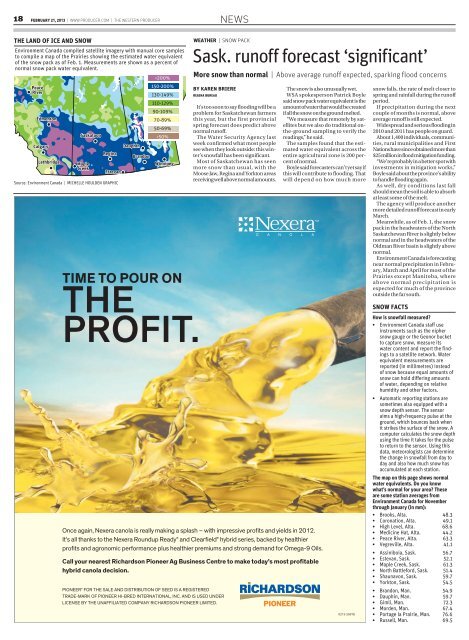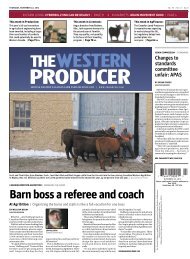18 FEBRUARY 21, 2013 | WWW.PRODUCER.COM | THE WESTERN PRODUCERNEWSWEATHER | SNOW PACKSask. runoff forecast ‘significant’More snow than normal | Above average runoff expected, sparking flood concernsTIME TO POUR ONTHEPROFIT.BY KAREN BRIEREREGINA BUREAUIt’s too soon to say flooding will be aproblem for Saskatchewan farmersthis year, but the first provincialspring forecast does predict abovenormal runoff.<strong>The</strong> Water Security Agency lastweek confirmed what most peoplesee when they look outside: this winter’ssnowfall has been significant.Most of Saskatchewan has seenmore snow than usual, with theMoose Jaw, Regina and Yorkton areasreceiving well above normal amounts.Once again, Nexera canola is really making a splash – with impressive profits and yields in 2012.It’s all thanks to the Nexera Roundup Ready ® and Clearfield ® hybrid series, backed by healthierprofits and agronomic performance plus healthier premiums and strong demand for Omega-9 Oils.Call your nearest Richardson Pioneer Ag Business Centre to make today’s most profitablehybrid canola decision.PIONEER ® FOR THE SALE AND DISTRIBUTION OF SEED IS A REGISTEREDTRADE-MARK OF PIONEER HI-BRED INTERNATIONAL, INC. AND IS USED UNDERLICENSE BY THE UNAFFILIATED COMPANY RICHARDSON PIONEER LIMITED.<strong>The</strong> snow is also unusually wet.WSA spokesperson Patrick Boylesaid snow pack water equivalent is theamount of water that would be createdif all the snow on the ground melted.“We measure that remotely by satellitesbut we also do traditional onthe-groundsampling to verify thereadings,” he said.<strong>The</strong> samples found that the estimatedwater equivalent across theentire agricultural zone is 200 percentof normal.Boyle said forecasters can’t yet say ifthis will contribute to flooding. Thatwill depend on how much more0213-20678snow falls, the rate of melt closer tospring and rainfall during the runoffperiod.If precipitation during the nextcouple of months is normal, aboveaverage runoff is still expected.Widespread and serious flooding in2010 and 2011 has people on guard.About 1,400 individuals, communities,rural municipalities and FirstNations have since obtained more than$25 million in flood mitigation funding.“We’re probably in a better spot withinvestments in mitigation works,”Boyle said about the province’s abilityto handle flooding again.As well, dry conditions last fallshould mean the soil is able to absorbat least some of the melt.<strong>The</strong> agency will produce anothermore detailed runoff forecast in earlyMarch.Meanwhile, as of Feb. 1, the snowpack in the headwaters of the NorthSaskatchewan River is slightly belownormal and in the headwaters of theOldman River basin is slightly abovenormal.Environment Canada is forecastingnear normal precipitation in February,March and April for most of thePrairies except Manitoba, whereabove normal precipitation isexpected for much of the provinceoutside the far south.SNOW FACTSHow is snowfall measured?• Environment Canada staff useinstruments such as the niphersnow gauge or the Geonor bucketto capture snow, measure itswater content and report the findingsto a satellite network. Waterequivalent measurements arereported (in millimetres) insteadof snow because equal amounts ofsnow can hold differing amountsof water, depending on relativehumidity and other factors.• Automatic reporting stations aresometimes also equipped with asnow depth sensor. <strong>The</strong> sensoraims a high-frequency pulse at theground, which bounces back whenit strikes the surface of the snow. Acomputer calculates the snow depthusing the time it takes for the pulseto return to the sensor. Using thisdata, meteorologists can determinethe change in snowfall from day today and also how much snow hasaccumulated at each station.<strong>The</strong> map on this page shows normalwater equivalents. Do you knowwhat’s normal for your area? <strong>The</strong>seare some station averages fromEnvironment Canada for Novemberthrough January (in mm):• Brooks, Alta. 48.3• Coronation, Alta. 49.1• High Level, Alta. 68.6• Medicine Hat, Alta. 44.2• Peace River, Alta. 63.3• Vegreville, Alta. 41.1• Assiniboia, Sask. 56.7• Estevan, Sask. 52.1• Maple Creek, Sask. 61.3• North Battleford, Sask. 51.4• Shaunavon, Sask. 59.7• Yorkton, Sask. 54.5• Brandon, Man. 54.9• Dauphin, Man. 59.7• Gimli, Man. 72.3• Morden, Man. 67.4• Portage la Prairie, Man. 76.6• Russell, Man. 69.5
NEWSTHE WESTERN PRODUCER | WWW.PRODUCER.COM | FEBRUARY 21, 2013 19CATTLE | GRAZINGNew forage variety intendedto reduce bloat in cattleGrows with alfalfa | Agriculture Canada develops new sainfoin cultivarthat reduces gas buildup seen in cattle foraging alfalfaBY BARB GLENLETHBRIDGE BUREAUA new forage variety may reducethe threat of bloat in cattle that grazealfalfa.Mountainview, a sainfoin cultivardeveloped by Agriculture Canadaforage breeder Surya Acharya, is aperennial that can be seeded withalfalfa and will prevent bloat in grazingcattle.Acharya announced the new varietyFeb. 5 at the Alberta Forage IndustryNetwork’s annual meeting inPonoka, Alta.In a later interview, he said developmentof the sainfoin took about 15years, the last four of which involvedfield testing to gauge the crop’s abilityto prevent bloat and survive in mixedstands.“We forage breeders are verypatient people,” Acharya said with alaugh about work he started in 1999on the variety.“I am very much pleased with it,particularly in Lethbridge. All theselections were done here so naturallyit did remarkably well here.”Bloat can be a serious problem forcattle grazing alfalfa. It is a highlynutritious feed that is quickly digested,but ingestion of large amountscan lead to fatal gas buildup. Thatthreat can limit its use.Sainfoin is a non-bloating forage.When seeded with alfalfa, cattleingest a mixture and the bloat threatis reduced.Don McLennan, past chair of theforage network, said Mountainviewis one of the most exciting researchresults in the industry in recent years.“It has the potential to have a verysignificant impact on both the forageand livestock industry in <strong>Western</strong>Canada and maybe even beyondbecause of the characteristics thatSurya has been able to build into thisnew variety.”He said alfalfa has excellent traitsfor putting pounds on cattle, but graziershave to be careful.“<strong>The</strong> fear of bloat can take away allthose positives in a big hurry.”However, he said adding sainfoin tothe grazing mix can reduce bloat riskwhile maintaining feed value.Acharya said Mountainview is trulyone of a kind. Most sainfoins do notregrow well after grazing or cuttingfor hay, but this one has shown itsability to regrow and retain biomassinto its fourth year.“Last year we had more than 30percent still there. Thirty percent ofthe biomass was still sainfoin, butthis year we will see what it has done.”Mountainview outyielded thecheck variety, Nova, by 22 to 42 percentin pure stands and by 30 to 39percent in mixed stands with alfalfa.It also reaches flowering 10 daysbefore Nova and has a heavier seedweight.Acharya said bloat prevention wasthe main focus of cultivar development,so he did not select for yield.That is why he was pleasantly surprisedat Mountainview’s continuedyield even after three or four cuts.Palatability also rates well, accordingto grazing observations.“It is as palatable or even bettersometimes than alfalfa because it hasa hollow stem. It does not have a solidstem so the animals can eat the wholething.”Acharya said cattle seem to beselecting sainfoin over alfalfa in initialgrazing, which bodes well forbloat prevention and has alleviatedfears that the crop’s bitter tanninswould inhibit grazing.He said Mountainview has a sweeterflower than alfalfa, and blossomsare more attractive than alfalfa forbees.He estimates a stand of 10 to 15 percentsainfoin would be enough forbloat prevention, although a higherpercentage might bring peace ofmind in patchy forage stands.<strong>The</strong> cultivar was tested under drylandand irrigated pasture conditionsin the Lethbridge area, and atSaskatoon and Swift Current, Sask.Breeder seed will be produced atAgriculture Canada’s Indian Headfacility and a distribution companywill be selected soon. Mountainviewseed is expected to be available for2015 planting.McLennan said that’s longer thanforage producers would like, nowthat they’ve heard about its potential.“Like a lot of others, I can hardlywait.”Acharya said he and his team willbe watching for disease issues onceMountainview is seeded over a widergeographic area and in rotation withother crops.None have arisen in field trials, butdisease pressure from precedingcrops might bring some to light.<strong>The</strong> forage researcher’s next focusis on an alfalfa variety that will growin acidic soil. He expects to apply forregistration soon.puts nutrientswhere they count:Awaken ® ST is a new nutrition loaded,growth enhancing seed treatment.Mountainview, a new forage variety developed by Agriculture Canada, isintended to be seeded with alfalfa. | AGRICULTURE CANADA PHOTOSBenefits of Awaken ST:ON THESEEDAwaken ST on HRS WheatAwaken STUTC40 45 50 55 60 65Bushel/acreMountainview outyielded Nova, the check variety of sainfoin, by 30 to39 percent in mixed stands with alfalfa.1-800-561-5444 www.uap.caAlways read and follow all label directions. Awaken is a registeredtrademark of Loveland Products Inc. UAP Canada is a member ofCropLife Canada. 01.13 13003
- Page 1 and 2: THURSDAY, FEBRUARY 21, 2013 VOL. 91
- Page 3 and 4: NEWS THE WESTERN PRODUCER | WWW.PRO
- Page 5 and 6: NEWS THE WESTERN PRODUCER | WWW.PRO
- Page 7 and 8: MARKETS THE WESTERN PRODUCER | WWW.
- Page 9 and 10: MARKETS THE WESTERN PRODUCER | WWW.
- Page 11 and 12: THE WESTERN PRODUCER | WWW.PRODUCER
- Page 13 and 14: OPINION THE WESTERN PRODUCER | WWW.
- Page 15 and 16: NEWS THE WESTERN PRODUCER | WWW.PRO
- Page 17: NEWSTHE WESTERN PRODUCER | WWW.PROD
- Page 21 and 22: THE WESTERN PRODUCER | WWW.PRODUCER
- Page 23 and 24: FARM LIVINGTHE WESTERN PRODUCER | W
- Page 25 and 26: FARM LIVINGTHE WESTERN PRODUCER | W
- Page 27 and 28: THE WESTERN PRODUCER | WWW.PRODUCER
- Page 29 and 30: NEWSTHE WESTERN PRODUCER | WWW.PROD
- Page 31 and 32: NEWSTHE WESTERN PRODUCER | WWW.PROD
- Page 33 and 34: RESEARCH | PHOTOSYNTHESISBY MARY MA
- Page 35 and 36: NEWSTHE WESTERN PRODUCER | WWW.PROD
- Page 37 and 38: NEWSTHE WESTERN PRODUCER | WWW.PROD
- Page 39 and 40: THE WESTERN PRODUCER | WWW.PRODUCER
- Page 41 and 42: THE WESTERN PRODUCER | WWW.PRODUCER
- Page 43 and 44: NEWSTHE WESTERN PRODUCER | WWW.PROD
- Page 45 and 46: NEWSTHE WESTERN PRODUCER | WWW.PROD
- Page 47 and 48: NEWSTHE WESTERN PRODUCER | WWW.PROD
- Page 49 and 50: THE WESTERN PRODUCER | WWW.PRODUCER
- Page 51 and 52: THE WESTERN PRODUCER | WWW.PRODUCER
- Page 53 and 54: THE WESTERN PRODUCER, THURSDAY, FEB
- Page 55 and 56: THE WESTERN PRODUCER, THURSDAY, FEB
- Page 57 and 58: THE WESTERN PRODUCER, THURSDAY, FEB
- Page 59 and 60: THE WESTERN PRODUCER, THURSDAY, FEB
- Page 61 and 62: THE WESTERN PRODUCER, THURSDAY, FEB
- Page 63 and 64: THE WESTERN PRODUCER, THURSDAY, FEB
- Page 65 and 66: THE WESTERN PRODUCER | WWW.PRODUCER
- Page 67 and 68: AstroOVER400CAR & TRUCK SALES LTD.
- Page 69 and 70:
HUGEBLOWOUT!SAVE BIG!2011 FORD F150
- Page 71 and 72:
THE WESTERN PRODUCER, THURSDAY, FEB
- Page 73 and 74:
THE WESTERN PRODUCER, THURSDAY, FEB
- Page 75 and 76:
THE WESTERN PRODUCER, THURSDAY, FEB
- Page 77 and 78:
THE WESTERN PRODUCER, THURSDAY, FEB
- Page 79 and 80:
THE WESTERN PRODUCER, THURSDAY, FEB
- Page 81 and 82:
THE WESTERN PRODUCER, THURSDAY, FEB
- Page 83 and 84:
THE WESTERN PRODUCER, THURSDAY, FEB
- Page 85 and 86:
NEWSTHE WESTERN PRODUCER | WWW.PROD
- Page 87 and 88:
THE WESTERN PRODUCER | WWW.PRODUCER
- Page 89 and 90:
PRODUCTIONTHE WESTERN PRODUCER | WW
- Page 91 and 92:
PRODUCTIONTHE WESTERN PRODUCER | WW
- Page 93 and 94:
NEWSTHE WESTERN PRODUCER | WWW.PROD
- Page 95 and 96:
THE WESTERN PRODUCER | WWW.PRODUCER
- Page 97 and 98:
LIVESTOCKTHE WESTERN PRODUCER | WWW
- Page 99 and 100:
LIVESTOCKTHE WESTERN PRODUCER | WWW
- Page 101 and 102:
AGFINANCETHE WESTERN PRODUCER | WWW
- Page 103 and 104:
WEATHERTHE WESTERN PRODUCER | WWW.P








